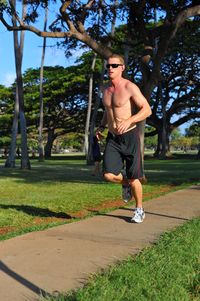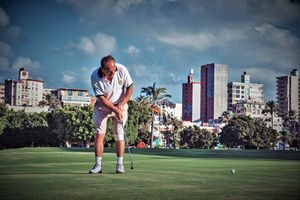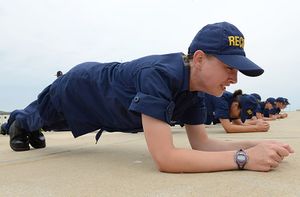Physical Activity and Men: Difference between revisions
mNo edit summary |
Kim Jackson (talk | contribs) m (Text replacement - "[[Hip Fracture|" to "[[Femoral Neck Hip Fracture|") |
||
| (47 intermediate revisions by 9 users not shown) | |||
| Line 1: | Line 1: | ||
[[ | <div class="editorbox"> | ||
'''Original Editor '''- [[User:Ilona Malkauskaite|Ilona Malkauskaite]] | |||
'''Top Contributors''' - {{Special:Contributors/{{FULLPAGENAME}}}} | |||
</div> | |||
== Introduction == | == Introduction == | ||
[[Physical activity | Physical Activity (PA)]] is defined as any bodily movement produced by skeletal muscles that requires energy expenditure | [[File:Exercise.jpg|right|frameless|301x301px]] | ||
There is an increasing focus on the benefits of physical activity (PA) and encouraging the Worldwide community to become more physically active. Physical activity is important for both physical and mental health. | |||
* Lack of PA is linked to a range of serious health problems including [[obesity]], [[Cardiovascular Disease|heart disease]] and some forms of [[Oncology|cancer.]] | |||
The most common reasons given by men not being physically active are insufficient time because of work or study commitments, lack of interest, age (‘I’m too old’) and ongoing injuries or illness<ref name=":0">Beeter Health Vic Govt. [https://www.betterhealth.vic.gov.au/health/healthyliving/physical-activity-for-men?viewAsPdf=true Physical activity for men] Available from:https://www.betterhealth.vic.gov.au/health/healthyliving/physical-activity-for-men?viewAsPdf=true (last accessed 18.2.2020)</ref>. | |||
* According to World Health Organisation (WHO), men were slightly more physically active than women in 2010 globally. | |||
* less than 1/2 of men aged 18–64 are sufficiently active. This number drops to 1 in 4 for men aged over 65. In addition, 7 in 10 Australian males are overweight or obese.<ref name=":1">Exercise Right | |||
[https://exerciseright.com.au/why-is-exercise-important-for-mens-health/ WHY IS EXERCISE IMPORTANT FOR MEN’S HEALTH?] Available from: | |||
☀https://exerciseright.com.au/why-is-exercise-important-for-mens-health/ (last accessed 18.2.2020) | |||
</ref> | |||
* Overall around 23% of adults aged 18 and over were not active enough in 2010 (men 20% and women 27%) <ref>World Health Organization. Physical Activity. Available from:http://www.who.int/mediacentre/factsheets/fs385/en/ (Accessed 18 April 2018).</ref>. | |||
=== Perceived barriers to physical activity === | |||
There are several common reasons why some men don’t exercise: | |||
* Lack of time for physical activity (Men aged between 30 and 50 are typically busy with work and family commitments). When leisure time is limited, it’s natural to choose enjoyable activities. If men don’t view physical activity as enjoyable, they won’t do it. | |||
* Lack of interest in physical activity. Some men believe in the ‘no pain, no gain’ misconception, and think that only gruelling and uncomfortable forms of physical activity are worthwhile. However, physical activity doesn’t have to be particularly vigorous. | |||
* Lack of motivation about physical activity. Some men view health as a low priority. | |||
* Lack of physical ability. Health issues that make activity and movement uncomfortable such as obesity, back pain or persistent fatigue are a common barrier to regular participation in physical activity. | |||
* Limited access to exercise facilities. Some men think its all about gyms etc. Not so eg. activities that don’t require facilities or equipment, such as walking.<ref name=":0" /> | |||
=== [[Physical activity |Physical Activity (PA)]] === | |||
[[File:Golf.jpg|right|frameless]] | |||
is defined as any bodily movement produced by skeletal muscles that requires energy expenditure, including activities undertaken while | |||
* working | |||
* playing | |||
* carrying out household chores | |||
* active travelling | |||
* engaging in recreational pursuits. | |||
Regular physical activity helps to maintain a healthy body weight and reduce the risk of many chronic conditions and injuries. | |||
A high level of cardiorespiratory fitness is also one of the best predictors of overall health and well-being.<ref name=":1" /> | |||
Regular moderate intensity physical activity has significant benefits for health. This includes walking, cycling, or participating in sports. Benefits of PA include reduced risk of | |||
* [[Cardiovascular Disease|cardiovascular]] diseases, | |||
* [[diabetes]] | |||
* colon and breast cancer | |||
* [[depression]] | |||
* will decrease the risk of a [[Femoral Neck Hip Fracture|hip]] or vertebral fracture | |||
* help control weight<ref>World Health Organization. Physical Activity. Available from: http://www.who.int/topics/physical_activity/en/<nowiki/>(Accessed 18 April 2018). | |||
</ref>. | </ref>. | ||
To find out more about gender differences in physical activity and sedentary time, you can view this video below: | |||
{{#ev:youtube|dWgTRbvJ66I}} | |||
== The benefits of physical activity in men with cardiovascular diseases == | |||
[[File:Plank exercise.jpg|right|frameless]] | |||
Physical activity clearly decreases the risk of developing coronary heart disease (CHD). It is less clear how much physical activity is needed. | |||
* Those engaging in the equivalent of 300 min/week of moderate-intensity leisure-time activity had a 20% lower risk. | |||
* Those engaging in the equivalent of 150 mins per week of moderate-intensity leisure-time physical activity had a 14% lower risk. | |||
* Lower relative risks among persons who were physically active below the basic guideline (but above those with poorer levels of PA) supporting the guideline’s assertion that some physical activity is better than none. <ref>Sattelmair J, Pertman J, Ding E, Kohl H, Haskell W, Lee I.[https://www.ncbi.nlm.nih.gov/pmc/articles/PMC3158733/ Dose response between physical activity and risk of coronary heart disease: a meta-analysis.] Available from:https://www.ncbi.nlm.nih.gov/pmc/articles/PMC3158733/ Circulation 2011; ;124(7):789-95. (last accessed 18.2.2020)</ref>. | |||
* In a large prospective study of U.S. men vigorous-intensity physical activity, even at ≥ 70 MET-hours per week, was associated with decreased risk of incident of major chronic disease and total cardiovascular disease. | |||
* Running, tennis, and brisk walking were each associated with reduced risk for developing of cardiovascular disease <ref>Chomistek A, Cook N, Flint A,Rimm E. Vigorous-intensity leisure-time physical activity and risk of major chronic disease in men.Med Sci Sports Exerc 2012; 44:1898–1905.</ref>. | |||
== The benefits of physical activity in | == The benefits of physical activity in men with [[Chronic Disease|chronic conditions]] == | ||
* Weight reduction for men is best achieved and maintained with combination of reducing diet, physical activity or physical activity programme and behaviour change techniques <ref>Robertson C, Archibald D, Avenell A, Douglas F, Hoddinott P, Teijlingen et al.Systematic reviews of and integrated report on the quantitative, qualitative and economic evidence base for the management of obesity in men. Health Technol Assess 2014;18(35).</ref>. | |||
* Increased intensity of physical activity was associated with loss of fat mass in severely obese men <ref>Aadland E, Jepsen R, Andersen J, Anderssen S. Differences in fat loss in response to physical activity among severely obese men and women. J Rehabil Med 2014;46:363-9.</ref>. | |||
* Higher levels of physical activity were associated with a reduced risk of developing type 2 diabetes <ref>Ekelund U, Palla L, Brage S, Franks P, Peters T, Balkau B et al.Physical activity reduces the risk of incident type 2 diabetes in general and in abdominally lean and obese men and women: the EPIC-InterAct Study. Diabetologia 2012 ;55:1944-52.</ref>. | |||
* Higher levels of leisure-time physical activity may lower risk of: chronic pelvic pain syndrome; chronic [[Prostate Cancer|prostatitis]], in middle-aged and older men<ref>Zhang R, Andrea K, Chomistek J, Dimitrakoff E,. Giovannucci W. Willett B. Physical Activity and Chronic Prostatitis/Chronic Pelvic Pain Syndrome. Med Sci Sports Exerc 2015; 47: 757–764.</ref>. | |||
== The benefits of physical activity in men with prostate cancer == | == The benefits of physical activity in men with prostate cancer == | ||
The effects of exercise on cancer-specific quality of life in men with prostate cancer | |||
* Improved cancer specific quality of life and cancer specific fatigue in men with prostate cancer (at up to 6 months of follow up). | |||
* Positive beneficial effects for lower body strength and aerobic fitness<ref>Bourke L, Smith D, Steed L, Hooper R, Carter A, Catto J, et al. Exercise for Men with Prostate Cancer: A Systematic Review and Meta-analysis.Eur Urol 2016;69:693-703. </ref>. | |||
* Physical activity was associated with lower overall mortality in men with prostate cancer. Both non-vigorous activity and vigorous activity showed significant results <ref>Kenfield S, Stampfer M, Giovannucci E, Chan J. Physical Activity and Survival After Prostate Cancer Diagnosis in the Health Professionals Follow-Up Study. Journal of Clinical Oncology 2011;29:726-732. </ref>. | |||
Exercising as a factor to reduce the risk of prostate cancer is still not clear<ref>Shephard RJ. Physical activity and prostate cancer: an updated review. Sports Medicine. 2017 Jun 1;47(6):1055-73.</ref>. | |||
For further information you can watch this video on Activity and Prostate Cancer: | |||
{{#ev:youtube|rMoCHa1w-qA}} | |||
== References == | == References == | ||
<references /> | <references /> | ||
[[Category:Physical_Activity]] [[Category:Physical_Activity_Content_Development_Project]] | [[Category:Physical_Activity]] | ||
[[Category:Physical_Activity_Content_Development_Project]] | |||
[[Category:Course Pages]] | |||
Latest revision as of 12:04, 19 December 2022
Original Editor - Ilona Malkauskaite
Top Contributors - Ilona Malkauskaite, Lucinda hampton, Mariam Hashem, Kim Jackson, Tarina van der Stockt, Simisola Ajeyalemi, Admin, Tony Lowe, Michelle Lee and Rucha Gadgil
Introduction[edit | edit source]
There is an increasing focus on the benefits of physical activity (PA) and encouraging the Worldwide community to become more physically active. Physical activity is important for both physical and mental health.
- Lack of PA is linked to a range of serious health problems including obesity, heart disease and some forms of cancer.
The most common reasons given by men not being physically active are insufficient time because of work or study commitments, lack of interest, age (‘I’m too old’) and ongoing injuries or illness[1].
- According to World Health Organisation (WHO), men were slightly more physically active than women in 2010 globally.
- less than 1/2 of men aged 18–64 are sufficiently active. This number drops to 1 in 4 for men aged over 65. In addition, 7 in 10 Australian males are overweight or obese.[2]
- Overall around 23% of adults aged 18 and over were not active enough in 2010 (men 20% and women 27%) [3].
Perceived barriers to physical activity[edit | edit source]
There are several common reasons why some men don’t exercise:
- Lack of time for physical activity (Men aged between 30 and 50 are typically busy with work and family commitments). When leisure time is limited, it’s natural to choose enjoyable activities. If men don’t view physical activity as enjoyable, they won’t do it.
- Lack of interest in physical activity. Some men believe in the ‘no pain, no gain’ misconception, and think that only gruelling and uncomfortable forms of physical activity are worthwhile. However, physical activity doesn’t have to be particularly vigorous.
- Lack of motivation about physical activity. Some men view health as a low priority.
- Lack of physical ability. Health issues that make activity and movement uncomfortable such as obesity, back pain or persistent fatigue are a common barrier to regular participation in physical activity.
- Limited access to exercise facilities. Some men think its all about gyms etc. Not so eg. activities that don’t require facilities or equipment, such as walking.[1]
Physical Activity (PA)[edit | edit source]
is defined as any bodily movement produced by skeletal muscles that requires energy expenditure, including activities undertaken while
- working
- playing
- carrying out household chores
- active travelling
- engaging in recreational pursuits.
Regular physical activity helps to maintain a healthy body weight and reduce the risk of many chronic conditions and injuries.
A high level of cardiorespiratory fitness is also one of the best predictors of overall health and well-being.[2]
Regular moderate intensity physical activity has significant benefits for health. This includes walking, cycling, or participating in sports. Benefits of PA include reduced risk of
- cardiovascular diseases,
- diabetes
- colon and breast cancer
- depression
- will decrease the risk of a hip or vertebral fracture
- help control weight[4].
To find out more about gender differences in physical activity and sedentary time, you can view this video below:
The benefits of physical activity in men with cardiovascular diseases[edit | edit source]
Physical activity clearly decreases the risk of developing coronary heart disease (CHD). It is less clear how much physical activity is needed.
- Those engaging in the equivalent of 300 min/week of moderate-intensity leisure-time activity had a 20% lower risk.
- Those engaging in the equivalent of 150 mins per week of moderate-intensity leisure-time physical activity had a 14% lower risk.
- Lower relative risks among persons who were physically active below the basic guideline (but above those with poorer levels of PA) supporting the guideline’s assertion that some physical activity is better than none. [5].
- In a large prospective study of U.S. men vigorous-intensity physical activity, even at ≥ 70 MET-hours per week, was associated with decreased risk of incident of major chronic disease and total cardiovascular disease.
- Running, tennis, and brisk walking were each associated with reduced risk for developing of cardiovascular disease [6].
The benefits of physical activity in men with chronic conditions[edit | edit source]
- Weight reduction for men is best achieved and maintained with combination of reducing diet, physical activity or physical activity programme and behaviour change techniques [7].
- Increased intensity of physical activity was associated with loss of fat mass in severely obese men [8].
- Higher levels of physical activity were associated with a reduced risk of developing type 2 diabetes [9].
- Higher levels of leisure-time physical activity may lower risk of: chronic pelvic pain syndrome; chronic prostatitis, in middle-aged and older men[10].
The benefits of physical activity in men with prostate cancer[edit | edit source]
The effects of exercise on cancer-specific quality of life in men with prostate cancer
- Improved cancer specific quality of life and cancer specific fatigue in men with prostate cancer (at up to 6 months of follow up).
- Positive beneficial effects for lower body strength and aerobic fitness[11].
- Physical activity was associated with lower overall mortality in men with prostate cancer. Both non-vigorous activity and vigorous activity showed significant results [12].
Exercising as a factor to reduce the risk of prostate cancer is still not clear[13].
For further information you can watch this video on Activity and Prostate Cancer:
References[edit | edit source]
- ↑ 1.0 1.1 Beeter Health Vic Govt. Physical activity for men Available from:https://www.betterhealth.vic.gov.au/health/healthyliving/physical-activity-for-men?viewAsPdf=true (last accessed 18.2.2020)
- ↑ 2.0 2.1 Exercise Right WHY IS EXERCISE IMPORTANT FOR MEN’S HEALTH? Available from: ☀https://exerciseright.com.au/why-is-exercise-important-for-mens-health/ (last accessed 18.2.2020)
- ↑ World Health Organization. Physical Activity. Available from:http://www.who.int/mediacentre/factsheets/fs385/en/ (Accessed 18 April 2018).
- ↑ World Health Organization. Physical Activity. Available from: http://www.who.int/topics/physical_activity/en/(Accessed 18 April 2018).
- ↑ Sattelmair J, Pertman J, Ding E, Kohl H, Haskell W, Lee I.Dose response between physical activity and risk of coronary heart disease: a meta-analysis. Available from:https://www.ncbi.nlm.nih.gov/pmc/articles/PMC3158733/ Circulation 2011; ;124(7):789-95. (last accessed 18.2.2020)
- ↑ Chomistek A, Cook N, Flint A,Rimm E. Vigorous-intensity leisure-time physical activity and risk of major chronic disease in men.Med Sci Sports Exerc 2012; 44:1898–1905.
- ↑ Robertson C, Archibald D, Avenell A, Douglas F, Hoddinott P, Teijlingen et al.Systematic reviews of and integrated report on the quantitative, qualitative and economic evidence base for the management of obesity in men. Health Technol Assess 2014;18(35).
- ↑ Aadland E, Jepsen R, Andersen J, Anderssen S. Differences in fat loss in response to physical activity among severely obese men and women. J Rehabil Med 2014;46:363-9.
- ↑ Ekelund U, Palla L, Brage S, Franks P, Peters T, Balkau B et al.Physical activity reduces the risk of incident type 2 diabetes in general and in abdominally lean and obese men and women: the EPIC-InterAct Study. Diabetologia 2012 ;55:1944-52.
- ↑ Zhang R, Andrea K, Chomistek J, Dimitrakoff E,. Giovannucci W. Willett B. Physical Activity and Chronic Prostatitis/Chronic Pelvic Pain Syndrome. Med Sci Sports Exerc 2015; 47: 757–764.
- ↑ Bourke L, Smith D, Steed L, Hooper R, Carter A, Catto J, et al. Exercise for Men with Prostate Cancer: A Systematic Review and Meta-analysis.Eur Urol 2016;69:693-703.
- ↑ Kenfield S, Stampfer M, Giovannucci E, Chan J. Physical Activity and Survival After Prostate Cancer Diagnosis in the Health Professionals Follow-Up Study. Journal of Clinical Oncology 2011;29:726-732.
- ↑ Shephard RJ. Physical activity and prostate cancer: an updated review. Sports Medicine. 2017 Jun 1;47(6):1055-73.









